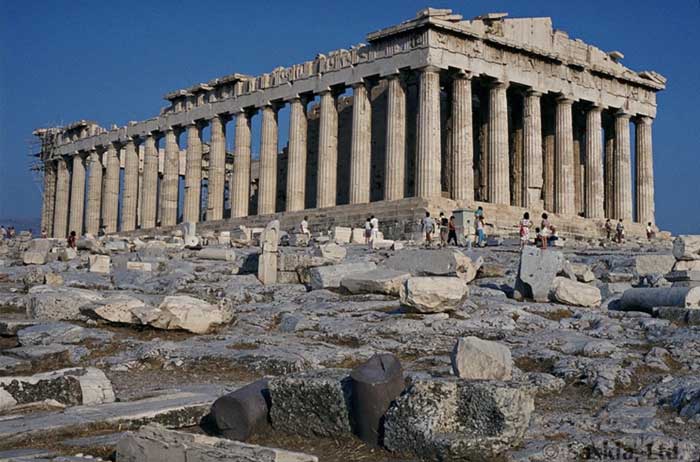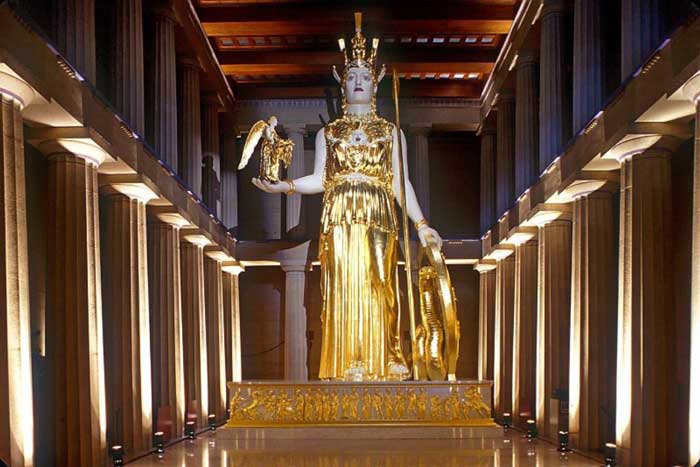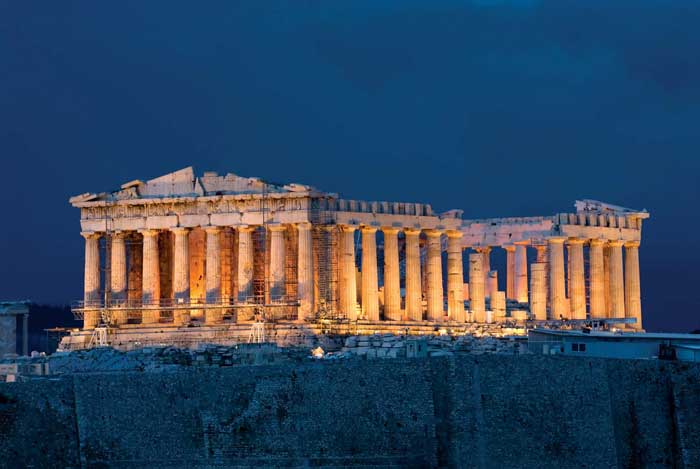
Built between 447 and 432 BCE in the Age of Pericles, the majestic temple, that dominates the hill of the Acropolis in Athens and known as the Parthenon, was dedicated to the city’s patron deity Athena. Designed by the architects Iktinos and Kallikratis, the temple was basically constructed to house the new statue of the goddess, crafted by Pheidias, as well as to proclaim the success of Athens as the leader of the Greek forces that had defeated the invading Persian armies of Darius and Xerxes.
Construction of the temple was projected to replace the damaged buildings of the Acropolis, following the Persian attack on the city in 480 BCE and was funded by the treasury of the Delian League, a political alliance of Greek city-states formed together to repel the possible threat of the Persian invasions. Gradually, as the confederation of the states transformed into the Athenian Empire, Pericles used the funds of the league to start the massive building project to glorify Athens.
The magnificent temple, projected on the highest part of the acropolis, was made of Pentelic marble acquired from the nearby Mount Pentelicus, which was known for its pure white appearance and fine grain. However, since it contains traces of iron, it has oxidised over time and the marble became soft honey coloured, which become very much evident at sunrise and sunset. Though the temple is considered as the largest Doric Greek temple, it was constructed with the two architectural styles of Doric and the newer Ionic and its architecture is considered as the role model even during the period of antiquity. The huge outer columns of the temple were Doric, out of which eight could be seen from the front and back and the other 17 could be seen only from the sides, which was in contrast to the normal Doric arrangement. Apart from that, they were also slimmer and closer together than usual.



The cella or the inner chamber had six columns at the back and the front and its large wooden doors were embellished with bronze, ivory and gold. Out of the two rooms of the cella, the smaller room contained four Ionic columns to support the roof section and was used as the city’s treasury, while the larger room, surrounded by a Doric colonnade on three sides, housed the cult statue of the goddess. The roof of the gigantic structure was constructed with cedar wood beams and marbles and the corners of the roof were equipped with lion-headed spouts to drain away water.
The quantity and quality of architectural sculpture that decorated the temple, was simply unprecedented. It had 92 square spaces or ‘metopes’, carved in high relief, running around the exterior of the temple, 32 along the long sides and 14 on each of the short. They were decorated with figures of the Olympian gods fighting the giants, fighting Greeks against the Amazons, the Fall of Troy and Greeks fighting Centaurs, possibly at the wedding of Perithous, the mythological king of the Lapiths in Thessaly. The decoration of the frieze is unlike any other previous Greek temples. Running around all four sides of the building, it depicted a single subject, the procession of the Panathenaic games, which was held in Athens every four years.



The graceful and huge pediments of the temple are 28.55 m long, with a maximum height of 3.45 m at their centre. Though they were skillfully ornamented with around 50 figures, today out of the fifty, only eleven figures survive. Unfortunately, their condition is so poor that, though it is possible to identify the general subjects, it is difficult to identify the figures with certainty. The birth of Athena was depicted in the east pediment, while the west side narrates the competition between Athena and Poseidon to become patron of the great city.
The most important sculpture of the great temple was the statue of Athena, which housed inside. It is evident that the huge temple of the Parthenon was built to accommodate the stupendous statue of Athena by Pheidias. The amazing statue with a height of over 12 m was built around a wooden frame with carved ivory for flesh parts and an unbelievable quantity of 1140 kilos of gold leaf to create the garments, armour, hair, and other details. Glass, precious and semi- precious stones were also used for detail such as eyes, jewelry, and weaponry. If necessary, or in case of any crisis, the gold parts could be easily removed. The pedestal of the statue measured 4.09 by 8.04 metres.


The original statue was somehow lost or was probably removed and shifted to Constantinople in the 5th century AD. But, the smaller Roman copies show fully armed Athena wearing an aegis with the head of Medusa prominent, her helmet adorned with a Sphinx and two griffins, holding Nike in her right hand and with a shield in her left hand, standing gracefully with a large coiled snake resided behind the shield. There was a large shallow basin of water in front of the statue, which acted as a reflector of light coming through the doorway and was also used to add the humidity, necessary for the preservation of the ivory. The artistically beautiful statue, with its richness and awe-inspiring presence was a clear message of the wealth and power of the city that could produce such a grand tribute to their patron god.
In the 5th century AD, the early Christians converted this wonderful pagan temple into a church. During those days, windows were set into the walls, which destroyed some parts of the frieze, and a bell tower was added to the west end. Apart from that, the figures in the central part of the east pediment were removed and the relief works on the other sides of the building were deliberately damaged. After surviving for another thousand years in its new form, the building was converted into a mosque in 1458 AD, by the occupying Turks, when a minaret was added in the southwest corner. After more than two hundred years, the Venetian army under General Francesco Morosini besieged the acropolis in 1687 AD. During those days, the Parthenon was used by the occupying Turkish forces as a powder magazine. As luck would have it, during the siege, a direct hit from a Venetian shell ignited the magazine and the resulting massive explosion ripped apart the Parthenon on the 26th of September.


In the devastating impact of the explosion, all the interior walls of the building, except the east side, were simply blown out and columns on the south and the north sides were collapsed. However, that was not the end of it. The beautiful central figures of the western pediment were damaged by Morosini, as he unsuccessful attempted to plunder them. He also smashed to pieces the horses from the west pediment when his effort of lifting them collapsed miserably. Even the remaining rubble was not spared, the Turks cleared a portion of it to build a smaller mosque. Unfortunately, nobody cared to restore the fallen ruins or protect them from the casual artifact robbers or the tourists and the souvenir mongers.

It was in the year 1801, when Thomas Bruce, the 7th Earl of Elgin, the British ambassador at Constantinople, proposed to pay a considerable amount of money to the indifferent Turkish authorities for the right to take away a large collection of the sculptures, inscriptions, and architectural pieces from the Acropolis. Ridiculously, the Turkish authorities agreed to it. The British Government bought the collection in 1816 AD and the said architectural pieces are now displayed in the British Museum in London, as the Elgin Marbles or the Parthenon Marbles. It is interesting to note that, since 1983, the Greek government has been campaigning to regain the possession of the sculptures